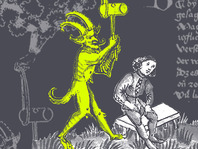Latencies of individual morality and scenes of collective vigilance between humans and spirits in pre-modern Europe
 Project A02
Project A02
Principal Investigators
Dr. Carolin Struwe-Rohr; Prof. Dr. Michael Waltenberger
Researchers
David Brißlinger; Katharina Brost
Project Description
Both transcendental salvation and vigilance against the dangers of evil demand equal degrees of attention simultaneously. However, this is often neither practically nor narratively easily accomplishable. If the former is forced, characteristic latencies of unresolved moral ambivalence emerge, which the project aims to analyse based on legendary narratives. If the moral conflict is dramatised as a struggle between good and evil spirit beings, the moral imputability of the subject is eroded. We will examine these effects looking at various designs of the collective organisation of angels and devils.
1. Funding phase
Diabolic Vigilance: Internalised Alertness and Social Control in Tales About the Devil from the Late Medieval and Early Modern Periods
Principal Investigators
Dr. Carolin Struwe-Rohr; Prof. Dr. Michael Waltenberger
Researchers
Alena Marti-Ruland; Hannah Michel
Project Description
The figure of the Devil significantly shaped cultural ideas of a morally grounded vigilance in early modern Christian Europe, which, in turn, influenced social practices.
The project A02 aims to investigate narrative texts (collections of exemplary or comic tales, compilations of 'Tragica' and 'Teufelbücher', amongst others), as well as picture-text-combinations (such as broadsheets), from the late medieval and early modern periods, which present individual cases of societal and juridical relevance in which demonic or diabolic figures are presented as observers lurking in the background, but also as threats that must be heeded vigilantly and constantly. In this way, forms of social control and phenomena of internalised vigilance can be modelled in a particularly striking fashion.
Our research will, not least, deal with questions relating to the transition/transformation of this form of staged diabolic vigilance over the threshold of the early modern period, as well as with regards to the dawn of the Reformation and confessionalisation.

